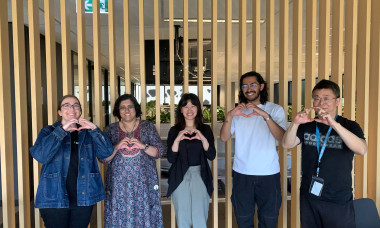A mechanic’s view on VET completion success
Phillip Cue has seen a lot of apprentices and trainees enter Australia’s automotive industry. When general manager of training at the Motor Traders’ Association NSW in 2019, Phil told ReadyTech he was overseeing 1300 students, 60 per cent of whom are light and heavy vehicle mechanics.
The problem is, he’d also seen a lot of young apprentices leave - without completing their training.
“The problem with the young fellas and the young girls is that, often, they don’t know yet who they are, or where they fit in the world,” he says. “Their attitude is to try as many things as they can, and the result is that in a lot of cases they are starting and not finishing,” Cue says.
The completion conundrum
Cue started his own apprenticeship in heavy and light vehicle mechanics in 1974. With a natural passion for all things under the hood, he worked his way up from apprentice to roles including mechanic, foreman, workshops manager, dealership service manager, national warranty auditor and NSW service manager at different companies. He moved into vocational training at TAFE in 1999.
Unfortunately not all apprentices in Australia get as far with their training. Data from NCVER published in July 2019 showed individual completion rates for apprentices who commenced in 2014 was just 56.7 a year for all occupations, down 3.2 per cent from the previous year. Contract completion rates (individuals may complete their training under more than one contract) were just 49.4 per cent, down 3.6 per cent.
At the time Cue talked to ReadyTech back in 2019, he said that, since he had begun co-manging the MTA's RTO, enrolments had grown significantly from 700 to 1300. At the same time the training team had expanded from 12 to 22, all of whom were contributing to delivering pre-vocational training in seven schools and providing apprentice and traineeship training in workplaces across NSW and ACT.
While MTA’s student base was growing at a rate of 34 students a month, its completion experience reflected some of the dangers implied by the nationwide NCVER figures. For example, Cue said 60 per cent of the trainees who chose to leave MTA since their enrolment in January 2016 left the course or employer within the first 6-9 months of starting their course.
“It’s clear there is a danger time from the 3-9 month mark for our new apprentices and trainees. While we can’t be sure exactly where our apprentices and trainees end up - for example, they could leave their employer and start up with another, or leave their qualification and start another - it’s this period early on that seems to be the hot spot for problems in relation to completions," he said at the time.
Cue said this early period in an apprenticeship or traineeship can be a bit of a test for fledgling mechanics just starting out in their careers. “You are entering a contract between three or sometimes four parties, and we find many aren’t taking on the responsibility that goes with that. It’s the five-minute lifestyle, it’s a bit of a generational thing, their attention span isn’t long enough.”
For young apprentices coming out of school, Cue says two to four years greasing it out as an apprentice mechanic can seem like a lifetime. “They are still trying to find out who they are. They go from top of a school to the bottom rung of a workplace, where they are a junior and while earning money most are still living at home. They are testing the water more so now than other times.”
Training and communication
The MTA caters for both young apprentices and trainees and those who are over 30 (at present 33 per cent of enrolments come from the latter age bracket). Its workplace delivery model means trainees and apprentices (some of whom would otherwise need to travel up to 8 hours to their nearest TAFE delivery point for five-day-long attendance blocks seven times a year) get training that comes to them. Saving employers travel and accommodation costs, the MTA delivers 1-on-1 training across NSW once a month, and works with employers to see their students released from their role for three hours a week.
“It’s typically mechanical work. They are in there seeing the stuff all the time. It’s a matter of reorganising the work they’re involved in to have the ability to do work and gain the experience that relate to the upcoming assessments.”
Training is conducted by a network of trainers, half of whom are based outside of the Sydney area and are required to travel to see apprentices and supervisors on the ground across NSW. At present, only 30 per cent of MTA’s students are based in Sydney.
Trainers also essentially fulfil a role as MTA’s mentors. When problems crop up - like communication with a supervisor - usually Cue says talking to the trainer can resolve their problems. If there are communication problems with a trainer, MTA’s head mentor will step in, managing the apprentice and trainer relationship towards a solution. Cue says it is when the apprentice has stopped talking to a trainer that a real risk arises, but that this is a very rare occurrence among MTA’s trainees.
Recipe for success
Cue’s recipe for apprentice success may be frustrating to hear for RTOs and other educators. That’s because, although programs might support it, it’s not something ever truly in their complete control.
It turns out that, according to Cue, a successful student is someone who makes their job their hobby.
“I joke that if I go out in the rain I rust,” Cue says. “When I was learning the trade, I was playing and tinkering in my own time, doing my own projects at home, like fixing friend’s cars. Ever since 1974 - and it’s now 2019, it’s been a part of me and I never wanted to get too far away from that.”
Successful completions often make the job ‘part of their life’ just like Cue has done for 45 years.
“Apprentices are in there training for three or four years - it often goes past the three-year barrier. That’s a long time for a 17 or 18-year old - and even longer for a 35 year-old,” he says. “If the job becomes a part of you - that’s very helpful - rather than doing something that’s alien to your day-to-day life. In trades, there’s definitely more application to day-to-day life and that helps; in Australia, we have two and a half cars per family, so we have to rely on cars.”
Problems solved
Since joining TAFE in 1999 Cue’s passion for vocational education and training saw him rise to become head teacher at TAFE’s Wetherill Park Heavy Vehicles section in 2004. It was the same interest in training that saw him promoted from trainer to RTO senior manager at the MTA in 2016, and now General Manager of Training. Cue says that, while the industry is changing fast, he enjoys helping students see the potential in learning.
“What I enjoy is seeing a green apprentice come to the ‘lights on’ moment when they start to understand the principles and can know why and how things work,” he says. “The industry is moving faster than most. The vehicles of today have more technology and systems integration in them than you could poke a stick at. Helping the guys to know how to build in themselves the capability to diagnose and to adapt their learning to previously unknown systems and processes is very gratifying.”
The value of the mechanical trade runs deeply in Cue’s blood. Convinced of the value of the skills apprentices learn on the job, he says that if they complete, they go on to use those skills for life. “When they start at 17, they immediately start solving problems. Straight away their whole life becomes problem solving, and they can use that fundamental skill through their whole life, whether that’s changing the lights at home, or applying that skill to problems in an important relationship.”






